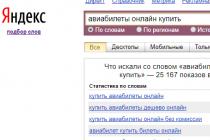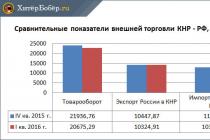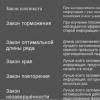Introduction ................................................ ................................................. ...............3
1. Composition of the defense industry complex of the Russian Federation ............................... ................................................. ...5
2. Legislative basis............................................................... ....................................6
3. Federal authorities executive power in the management of the military-industrial complex .............................................. ..................................16
3.1. Ministry of Defense of the Russian Federation ............................................... ......................17
3.2. Ministry of Industry and Energy of the Russian Federation.......................................19
3.2.1.Department of the military-industrial complex .............................19
3.2.2. federal agency by industry ..........................................22
3.3. Federal Space Agency ............................................................... ...........24
3.4. Federal Agency for Atomic Energy .............................................................. 25
3.5. Federal agency for the supply of military, special equipment and materiel .............................................................. ................................................. 28
3.6. Military-Industrial Commission under the Government of the Russian Federation.......................29
4. Expert Council on the problems of legislative support for the development of the military-industrial complex under the chairman of the Federation Council ................................................. ......................39
Conclusion................................................. ................................................. ........44
Introduction.
One of the most important means of ensuring national security is its armed forces, the military-industrial complex as a whole. National security - one of the main needs of the state and society - today is of the utmost importance for the successful implementation of its political, socio-economic, spiritual and ideological tasks. Hence the need for constant attention on the part of the state to the problems of the development of the military-industrial complex (DIC), the development and production of weapons and military equipment, the necessary level of scientific, technical and military-technical potentials, providing Russia with the role of a great power in the world. The need for such an understanding and real actions of the political leadership of the country is also due to the actions of Western countries, and above all the United States, seeking to change the balance of armed forces in their favor, both in the West and on the southern borders of Russia.
The development of the main directions and prospects for the development of the military-industrial complex is the responsibility of the state. It is designed to determine the directions of the state defense-industrial policy, the required level of the country's military-technical potential, taking into account the emerging international situation.
At the same time, it is important to take into account the historical experience of creating and developing the defense industry, accumulated in the USSR and over the last 15 years of the existence of the Russian state. Without taking into account the positive and negative aspects of this experience, it is impossible to determine the strategy for the development of the military-industrial complex. This largely determines the relevance of the chosen research topic, the need to analyze the problems of the defense industry in public policy modern Russia. At the same time, it is important to take into account the accumulated Foreign experience in this domain. Another relevant factor, along with the above, is a significant increase in the importance of information policy in armed struggle and confrontation between states, the introduction and use of a wide range of information warfare tools, both open and covert, non-explicit technologies. As a result, today the criteria for the protection of states from military threats turned out to be not fully appropriate modern methods, methods and forms of military confrontation. This, in turn, forces the political leadership of the world's leading states to intensify their efforts to improve and develop their military-industrial complexes and solve their socio-economic and political problems. It should also be noted such a feature of the functioning of the military-industrial complex as the desire of a number of international terrorist organizations to use its advanced technologies, especially weapons of mass destruction, for their own criminal purposes. After September 11, 2001, the tragic events with hostage-taking (in Moscow in October 2002, in Beslan in September 2004) it became completely clear that the Cold War had been replaced by a war of a completely different nature - the war against international terrorism . Therefore, the use of military force is one of the ways to counter such evil as the global spread of terrorist and extremist movements and groups.
All these objective factors necessitate the constant attention of the state to the problems of the defense industry, and the scientific community - to the analysis actual problems political and socio-economic development of the Russian military-industrial complex, the search for ways to improve its efficiency.
The object of study is the military-industrial complex Russian Federation as an important tool for ensuring the national security of the state.
Subject of study - system government controlled Russian military-industrial complex.
1. The composition of the defense industry complex of the Russian Federation.
Today, the military-industrial complex (hereinafter referred to as the MIC) of Russia is a multifunctional research and production industry capable of developing and producing modern types and types of weapons, military and special equipment (hereinafter referred to as AMSE), as well as producing a variety of science-intensive civilian products. Its basis is strategic enterprises and strategic joint-stock companies. The list of these enterprises and companies was approved by Decree of the President of the Russian Federation of August 4, 2004 No. 1009 (as amended on November 19, 2007). This list includes more than 1000 items, including:
federal state unitary enterprises that carry out the production of products (works, services) that have strategic importance to ensure the defense capability and security of the state, the protection of morality, health, rights and legitimate interests of citizens of the Russian Federation;
· open joint-stock companies, whose shares are in federal ownership and the participation of the Russian Federation in the management of which ensures the strategic interests, defense capability and security of the state, protection of morality, health, rights and legitimate interests of citizens of the Russian Federation.
The defense industry consists of several branches:
2. Rocket and space industry.
3. Industry of ammunition and special chemicals.
4. Arms industry.
5. Radio industry.
6. Communication industry.
8. Shipbuilding industry.
9. Intersectoral structures and enterprises.
2. Legislative framework.
The main law regulating the foundations for the existence and functioning of the military-industrial complex of the Russian Federation is the Federal Law of May 31, 1996 N 61-FZ "On Defense".
This Federal Law defines the foundations and organization of the defense of the Russian Federation, the powers of state authorities of the Russian Federation, the functions of state authorities of the constituent entities of the Russian Federation, organizations and their officials, the rights and obligations of citizens of the Russian Federation in the field of defense, the forces and means involved in defense, responsibility for violating the legislation of the Russian Federation in the field of defense, as well as other norms relating to defense.
Defense is understood as a system of political, economic, military, social, legal and other measures to prepare for armed defense and the armed defense of the Russian Federation, the integrity and inviolability of its territory.
Defense is organized and carried out in accordance with the Constitution of the Russian Federation, federal constitutional laws, federal laws, this Federal Law, laws of the Russian Federation and other regulatory legal acts.
For defense purposes, the military duty of citizens of the Russian Federation and the military transport duty of federal executive bodies, local governments and organizations, regardless of ownership, as well as owners Vehicle.
For defense purposes, the Armed Forces of the Russian Federation are being created. The internal troops of the Ministry of Internal Affairs of the Russian Federation are involved in the defense, troops civil defense(hereinafter - other troops).
To perform certain tasks in the field of defense, engineering and technical and road-building military formations under the federal executive authorities (hereinafter referred to as military formations), the Foreign Intelligence Service of the Russian Federation, bodies federal service security, federal agency for special communications and information, federal agencies state protection, the federal body for ensuring mobilization training of state authorities of the Russian Federation (hereinafter referred to as bodies), as well as special formations created for wartime.
The Armed Forces of the Russian Federation, other troops, military formations and bodies perform tasks in the field of defense in accordance with the Plan for the use of the Armed Forces of the Russian Federation.
The creation and existence of units that have a military organization or weapons and military equipment, or in which military service is provided for, not provided for by federal laws, are prohibited and prosecuted by law.
Lands, forests, waters and other natural resources provided to the Armed Forces of the Russian Federation, other troops, military formations and bodies are in federal ownership.
Lands, forests, waters and other natural resources owned by the constituent entities of the Russian Federation, local self-government bodies, in private ownership may be withdrawn for the needs of the Armed Forces of the Russian Federation, other troops, military formations and bodies only in accordance with the legislation of the Russian Federation.
Industrial policy in the military-industrial complex of the Russian Federation (hereinafter - the defense industry) is carried out in accordance with the goals, objectives and priority areas public policy in the field of development of the defense industry, approved by the President of the Russian Federation for a ten-year period and beyond, and the legislation of the Russian Federation in the field of defense.
One of the main tasks in the field of stimulating and supporting the innovative development of the defense industry, implementing it competitive advantage, promotion of technologies and industrial products to the markets of high-tech goods and services is the diversification of production through the use of dual-use technologies, increasing the production of civilian products and expanding the range. Order of the President of Russia No. Pr-2346 dated 05.12.2016 established the share of civilian and dual-use products in the total output of the military-industrial complex, which should increase to 30% by 2025 and up to 50% by 2030.
Today, it is extremely important to create a state demand for civilian products of the defense industry and develop an expanded list of products necessary for the implementation of national projects. The first step in this direction is to establish key indicators efficiency: an increase in the share of products purchased from defense enterprises - for large state-owned companies, an increase in the share of production of civilian goods - for defense organizations.
Under the so-called civilian procurement market, we propose to understand in this case special forms and methods of supplying goods, rendering works and services, with the exception of the state defense order (SDO).
Within the framework of national projects, the priority market niches for defense industry organizations today are: medicine, transport
construction, radio electronics, road construction equipment, power engineering and others. The capacity of these markets in terms of the competencies of defense industry organizations is now estimated at 1.2 trillion rubles.
In addition to national projects, a number of regulatory legal measures are already in place to stimulate the purchase of civilian products Russian defense organizations:
. a ban on foreign goods and services for the needs of the country's defense and state security (PP RF No. 9);
. restrictions and conditions of admission certain types foreign radio-electronic products (PP RF No. 968);
. a ban on the admission of products of the machine-tool industry for the needs of the country's defense (PP RF No. 239);
. limiting the admission of foreign weapons, ammunition and their parts (PP RF No. 1119);
. a ban on the purchase of furniture and woodworking industries originating from foreign countries (with the exception of the EAEU member states) for the purposes of procurement to meet state and municipal needs (RF GD
№ 1072);
. restrictions and conditions for the admission of drugs included in the list of vital and essential drugs (PP RF No. 1289);
. a ban on foreign light industry goods (PP RF No. 791);
. restrictions and access conditions for stents for coronary arteries, as well as catheters (PR RF No. 1469);
. a ban on the admission of certain types of engineering goods to meet state and municipal needs (PP RF No. 656);
. restrictions and conditions for admission of certain types of foreign medical devices(PP RF No. 102);
. prohibition on admission of foreign software to meet state and municipal needs (PP RF No. 1236).
At the same time, within the framework of diversification, organizations face a number of difficulties associated with entering new domestic Russian markets for civil products. Defense industry organizations carry out economic activity primarily for the sake of ensuring
defense and security of the state within the framework of the state defense order (hereinafter referred to as the GOZ). A fixed profitability has been established for the production of products supplied under the state defense order, state regulation applies to some defense products.
prices, which negatively affects the results of the financial and economic activities of organizations. The consequence of state regulation in the field of state defense orders is the lack of investment resources for defense enterprises that could be directed to the development and production of new civilian products.
In order to reduce barriers to entry into product markets, it is proposed to provide the possibility of establishing additional benefits for defense industry organizations when participating in the procurement process of civilian products. We believe that in order to adapt the defense industry to functioning in market conditions— it is necessary to provide a preferential regime for the supply of products (works, services) of defense industry organizations for state and municipal needs.
The possibility of establishing preferences (national treatment and features of its provision) is enshrined in paragraph 30 of the Protocol on the procedure for regulating procurement of the Treaty on the Eurasian economic union dated May 29, 2014
In the Russian Federation, this regime is implemented by Part 4 of Art. 14 of the Federal Law of April 5, 2013 No. 44-FZ “On contract system…”, according to which the federal executive body for the regulation of the contract system in the field of procurement establishes
admission conditions for the purposes of procurement of goods originating from a foreign state or a group of foreign states, works, services, respectively, performed, rendered foreign persons, with the exception of goods, works, services, in respect of which the Government of the Russian Federation has established a ban.
In pursuance of this provision of the law, by order of the Ministry of Finance of Russia dated 04.06.2018 No. 126n, these conditions are defined and the List of goods is approved, the consideration and evaluation of applications for which takes place with the application of a 15% reduction coefficient to the price of the contract proposed by the participant.
It is advisable to expand this list by including the main civilian products manufactured by defense industry organizations. According to our estimates, this will allow it to include at least 85 new categories (according to OKPD 2 codes) from among the range of products produced by defense industry organizations.
The proposed approach will allow defense industry organizations, whose civilian products, as a rule, have a high cost, including due to the specifics of defense industries, to compete on an equal footing with other suppliers in this parameter.
The transitional period, provided with preferential treatment, will be used by defense industry organizations to restructure the enterprise management system, including training personnel in marketing basics (determining promising competencies and sales markets), developing and launching competitive civilian products on the market, technical and technological re-equipment of enterprises.
The implementation of the preferential approach will contribute to sustainable development processes of diversification of the defense industry, growth business activity How industrial enterprises, and high-tech knowledge-intensive companies of small and medium-sized businesses.
CLUSTER PURCHASING
The implementation of measures related to the use of dual-use technologies and the expansion of the range of relevant products is one of the main system-wide tasks in the framework of the defense industry diversification. In addition to the preferential approach, a promising mechanism that, if implemented systematically, can provide an additional increase in the civilian production of the defense industry, can be the development of cluster interaction between defense organizations and innovative companies on the principles of partnership.
Certain positive results of the implementation of state support programs for innovation-territorial and industrial clusters can be noted. The Ministry of Industry and Trade of Russia is developing 43 industrial clusters, and the Ministry of Economic Development of Russia is developing 27 innovation-territorial clusters, including 12 world-class superclusters.
Already today, clusters have become an important driver of the socio-economic and industrial development of regions: new highly productive jobs are being created, and the tax base is growing. The mechanism has become widely demanded by representatives of both large and small and medium-sized businesses. Today, more than 600 organizations with an annual output of more than 1 trillion rubles are involved in industrial clusters alone. The funds invested by the state showed high efficiency, including within the framework of the implementation of import substitution programs and the creation of domestic competitive high-tech products.
The strength of the cluster approach is the so-called "team game" between the state-owned company and its suppliers in order to develop suppliers to the level at which they supply quality products at a favorable price.
Today in the college Military Industrial Commission The Russian Federation has a special Interdepartmental Working Group on the Dual-Use Scientific and Industrial Cluster. The dual purpose scientific and industrial cluster is special form cluster cooperation, based on the principles of public-private partnership with the participation of defense industry organizations and being an integrator of the regional scientific and industrial complex.
The purpose of dual-purpose scientific and industrial clusters is to ensure the preservation of the necessary infrastructure, industrial equipment, personnel of technological and scientific backlogs to quickly switch between modes of diversification and mobilization of the economy of defense industry enterprises and launch the processes of reindustrialization of the regional economy as a whole.
The specifics of the implementation of cluster mechanisms in the defense industry is largely related to the following aspects:
The core of the cluster is often made up of enterprises with state participation, which limits the space for market maneuver: defense industry organizations are forced to be guided not only by market requirements, but also by established tasks (tasks for state defense orders, maintaining mob capacities);
. the need for special competencies of an organization that claims to be the core of the cluster in the defense industry and ensure it professional staff(universities, research centers, etc.);
. the need for scientific, educational and engineering centers capable of transferring technologies in the field of defense industry diversification with appropriate access to information;
. the need to develop special mechanisms for the transfer of dual-use technologies related to pricing, depreciation of equipment, export-import operations, etc.;
. implementation of scientific and technical expertise and technology transfer, subject to the procedure for working with information of limited use.
One of the possible schemes for the formation of dual-purpose scientific and industrial clusters at the present stage can be the integration of innovation-territorial and industrial clusters with the participation interested organizations defense industry complex and special centers of competence in the regions of presence (see figure). The cluster approach opens up significant prospects for defense industry organizations, primarily related to the influx of new ideas and private investment in research and development, technology transfer and innovation, entry into new markets in the country and abroad. Involving residents of scientific and industrial clusters, on the one hand, will allow defense organizations to maintain strategic control over suppliers of different levels of cooperation and transfer part of the risks of attracting SMEs to state scientific organizations. On the other hand, the cluster procurement mechanism can provide additional solvent demand from the state for high-tech products, works and services, as well as create additional high-tech jobs based on attracted SMEs. It was precisely this issue - the relationship between the diversification of defense industry enterprises and socio-economic development in the regions of their presence - that the next meeting of the Interdepartmental working group on the dual-purpose scientific and industrial cluster, which took place on April 22, 2019 under the chairmanship of the Deputy Chairman of the Collegium of the Military Industrial Commission
Russian Federation O. I. Bochkareva on the topic: "About a dual-use cluster as an effective mechanism for diversifying organizations of the military-industrial complex and reindustrializing the regional economy of the Russian Federation." The meeting was attended by representatives of the Ministry of Economic Development of Russia, the Ministry of Industry and Trade of Russia, the Ministry of Defense of Russia, the Ministry of Education and Science of Russia, the Ministry of Natural Resources of Russia and the Ministry of Construction of Russia; directors of leading research organizations and defense industry enterprises, representatives of several banking structures and development institutions, as well as industrial regions Russia - the Moscow Region, the city of St. Petersburg, the Krasnoyarsk Territory and the Novosibirsk Region.
The participants of the meeting recognized the importance of coordinated interdepartmental work on the creation of organizational and legal mechanisms for ensuring activities for the formation of dual-purpose scientific and industrial clusters in order for the process of diversification of the defense industry to become a powerful driver of overall socio-economic development.
One of the mechanisms for the development of dual-use scientific and industrial clusters and the launch of the processes of reindustrialization of the regional economy, that is, the development of new high-tech industries that replace the old ones or contribute to their transfer to a new technological base, the participants also propose to consider an offset contract, which allows the customer to stimulate investment in new industries or upgrading existing facilities.
OFFSET CONTRACT
An offset contract allows the customer, in accordance with paragraph 48 of part 1 of article 93 44-FZ, to conclude a state (municipal) contract in the region with a supplier of goods that has established the appropriate production of goods under an offset contract. In other words, for investing in the production of the region, the investor is provided with guarantees for the sale of manufactured products to the state or municipal customer. Offset contract features:
1. The term of the offset contract is limited to 10 years.
2. The minimum investment should be 1 billion rubles.
3. An offset contract provides for a maximum period during which the creation or modernization and (or) development of production is carried out. The implementation of measures within the specified period allows the investor-supplier to conclude state (municipal) contracts in the region.
4. The offset contract specifies the executive authority of the subject of the Russian Federation, which establishes the procedure for determining the marginal price of a unit of goods, the production of which is created or modernized and (or) mastered, as well as the procedure for determining
contract prices.
Decree of the Government of the Russian Federation of December 22, 2016 No. 1441 in accordance with clause 48 of part 1 of article 93 44-FZ on the procedure for determining the maximum price of a unit of goods, the production of which is created or modernized and (or) mastered in the territory of a constituent entity of the Russian Federation in accordance with a state contract concluded with sole supplier goods - legal entity in accordance with Article 111.4 of the said Federal Law, as well as the procedure for determining the price of such a contract"
establishes the following requirements for the initial (maximum) contract price:
. if the goods are subject to tariff regulation, then the marginal price is established taking into account the legal acts on such regulation and cannot exceed the price determined in accordance with them;
. in other cases, the price is determined using the method of comparable market prices(market analysis), and if the product is sold at exchange auctions, it cannot exceed the price formed on them.
The price of the contract for the supply of goods is determined based on the marginal price of a unit of goods and the quantity (volume) of the purchased goods.
5. In accordance with Decree of the Government of the Russian Federation of November 12, 2016 No. 1166 “On establishing the features of procurement planning and holding tenders to determine the supplier with whom a state contract is concluded, providing for
counter investment obligations of the supplier-investor to create or modernize and (or) master the production of goods on the territory of the subject of the Russian Federation to meet the state needs of the subject of the Russian Federation "the supplier-investor provides security for the execution of the state contract in terms of investment obligations in the amount of 2 to 5% of the volume investment. The government contract may provide for the payment of an advance, which, in turn, may be conditional on the provision by the supplier-investor of security in the amount of the advance. This collateral is provided separately from the collateral described above relating to investment obligations.
The first offset contract was signed in Moscow in 2017 with the Biocad company, the contract amount is 14 billion rubles.
As part of the meeting of the Interdepartmental Working Group on the dual-purpose scientific and industrial cluster, representatives of the Project Office of the Ministry of Industry and Trade of Russia proposed to ensure the possibility of concluding offset contracts not only at the regional, but also at the interregional and federal levels, to extend the duration of contracts when implementing export-oriented projects, to reduce the minimum the level of investment in export-oriented projects and establish fixed obligations for the purchase by the customer to meet federal needs. These measures, according to the participants of the meeting, will make it possible to make investments in domestic industrial production more attractive for investors, expand the list of Russian-made products, including on the basis of scientific and industrial clusters with the participation of defense industry organizations.
As a result, according to the Minutes of the meeting of the Interdepartmental Working Group on the dual-purpose scientific and industrial cluster chaired by the Deputy Chairman of the Board of the Military Industrial Commission of the Russian Federation O. I. Bochkarev No. BO-P22-prVPK "Institute of Public-Private Planning together with the Russian Ministry of Defense, the Ministry of Education and Science of Russia, the Ministry of Economic Development of Russia, the Ministry of Industry and Trade of Russia, the Ministry of Construction of Russia, the Ministry of Natural Resources of Russia, the State Corporation Roscosmos, the State Corporation Vnesheconombank, the Advanced Research Foundation, FSUE VNII Center, FGBU Research Institute Voskhod, FGBUN Institute of Economics and Organization industrial production SB RAS", FSUE "Krylov State Research Center", FSBI "Federal Institute of Industrial Property" were instructed to:
- continue developing the organizational and legal framework for intensifying the processes of diversification of defense industry organizations by creating dual-use scientific and industrial clusters, including the creation of a Competence Center for dual-use clusters based on the ERA Military Innovation Technopolis
- assess the cluster potential of existing regional consortiums of enterprises producing high-tech civil and dual-use products, including those with the participation of defense industry organizations, identify the leader organization of the cooperative process in order to disseminate positive experience;
- prepare proposals for correction guidelines on the formation of Innovative Development Programs (IDP) by including in them the requirements for the priority and systematic selection of intellectual R&D results created in the course of the implementation of state programs (FTP) and the State Defense Order; introduction from 2019 of a system of expert opinions on assessing the effectiveness of design and development projects in terms of the implementation of intellectual R&D results in design and development projects;
- to develop and apply on the basis of the dual-purpose scientific and industrial clusters being created a single end-to-end cycle of scientific and technological development, provided with the necessary and sufficient measures state support, in order to expand the list of advanced technologies that are critical for strategic industries, as well as for the purpose of "implementing a joint project of industrial cluster participants to launch the production of a component base, taking into account the need to achieve growth rates in the supply of these industrial products to enterprises located in Russia" ( according to the minutes of the meeting with the Deputy Chairman of the Government of the Russian Federation D.N. Kozak dated January 31, 2019 No. DK-P9-18pr);
- prepare proposals on making the necessary changes and additions to the Federal Law of December 31, 2014 No. 488-FZ No. On Industrial Policy in the Russian Federation”.
The Institute for Public-Private Planning, together with the Ministry of Economic Development of Russia, to prepare recommendations for regional leaders on measures and comprehensive indicators of the effectiveness of support production programs enterprises by forming a guaranteed regional order”.
Journal "Government order: management, placement, provision" No. 56
Article Authors:
Antipina Elena Alexandrovna - Head of the Interdepartmental Working Group on the Dual-Use Scientific and Industrial Cluster of the Collegium of the Military Industrial Commission of the Russian Federation, CEO Institute for Public-Private Planning.
Zhurenkov Denis Alexandrovich - Head of the Information and Analytical Support Department of the Federal State Unitary Enterprise VNII Center (Ministry of Industry and Trade of Russia)
Sheloumov Mikhail Alexandrovich - Ph.D. in Law, Head of Methodology of State and Corporate Procurement of Electronic trading floor"GPB"
Current auctions
Name and number
Customer
Acceptance of applications
price, rub.
Other news
Diversification of the defense industry and implementation of national projects - what to expect from the upcoming Forum-exhibition "GOSZAKAZ"?
The eighth interactive round table "News in the legislation on public procurement: the Law on the contract system and Law No. 223-FZ" was held
Eighth Interactive Round Table "News in Public Procurement Legislation: Law on the Contract System and Law No. 223-FZ"
Training seminar in Ulyanovsk - Professionalism of customers as a factor in the effectiveness of the contract system in the field of procurement
ETP GPB experts took part in the "II Week of Contractual Relations and Procurement" in Ulyanovsk.
The Ministry of Agriculture has prepared amendments to the law to control the quality of purchased food
Defense-industrial complex. First, let's define the military-industrial complex, consider its composition, and discuss its features. Also in this lesson we will get acquainted with the role it plays in the life of our country.Subject: General characteristics of the Russian economy
Lesson: Defense Industrial Complex
Defense Industrial Complex (DIC) - a system of organizations and enterprises involved in the development and production of military equipment, weapons and ammunition.
Part Defense-industrial complex includes different types of enterprises and organizations.
1. Research organizations. They are engaged in theoretical research, on the basis of which new types of weapons are being developed.
2. Design bureaus. They create prototypes of weapons and ammunition and work out the technologies for their production.
3. Testing laboratories and testing grounds. Check prototypes in the field, as well as test finished products defense companies.
4. Manufacturing plants. Carry out mass production of weapons, military equipment, ammunition.
Rice. 1. Composition of the defense industry
A feature of the defense industry is that the need for its products is determined not by market mechanisms, but by the state and its defensive needs and economic opportunities.
Military equipment is one of the export items of Russia. This type of export is more profitable than the export of raw materials and materials.
Russia ranks first in the world in terms of trade in conventional arms, ahead of the US, France, Germany and the UK.

Rice. 2. Military equipment
Defense industrial complex can be considered as part of the machine-building complex, therefore, the same factors act on its deployment as in machine building, but for the defense industry the most important is the military-strategic one.
Military-strategic factor includes remoteness from state borders, placement of the most important enterprises in "closed" cities, where access is limited.
Most major industries OPKs are: Production nuclear weapons. This is the part nuclear industry includes mining of ore, production of uranium concentrate, uranium enrichment, fabrication of fuel elements, separation of weapons-grade plutonium, development of nuclear weapons and ammunition, and disposal of nuclear waste. Main centers Sarov and Snezhinsk .

Rice. 3. Nuclear weapons complex
Rocket and space industry. High science intensity and technical complexity of the manufactured products are the main features of this production. The main research institutes and design bureaus are located in Moscow and the Moscow region. The largest mass production missiles and spacecraft located in Voronezh, Samara, Zlatoust, Omsk, Krasnoyarsk, Zheleznogorsk. Ranges for launching missiles and testing rocket technology are located in sparsely populated areas: Cosmodrome "Plesetsk" the city of Mirny, Arkhangelsk region, Cosmodrome "Svobodny" Amur region.

Rice. 4. Launch complex Svobodny Cosmodrome
Aviation industry. The industry produces aircraft, helicopters, aircraft engines. Companies are located mainly in major cities V Volga region e and on the territory Central Russia.

Rice. 5. Russian aviation industry
Military shipbuilding. The industry is most often located in the same place as civil shipbuilding. The main center of shipbuilding is Saint Petersburg , scientific research institutes and design bureaus are also located here . Submarines are released in cities Severodvinsk (Arhangelsk region) , Komsomolsk-on-Amur, Big Stone (Primorsky Krai), in the Primorsky Territory and the Murmansk Region, the disposal of nuclear submarines.

Rice. 6. At the shipyard
armored industry. The main enterprises of this industry are located near metallurgical plants. Tanks are produced in Omsk and Nizhny Tagil , armored personnel carriers - in Arzamas , infantry fighting vehicles Kurgan
Manufacture of small arms and artillery weapons. From the 17th century to the present major center small arms production is Tula , since the 19th century, small arms have been produced in large volumes in Izhevsk . Famous hunting rifles and Kalashnikovs are made here.

Rice. 7. M.T. Kalashnikov
The production of artillery weapons since the time of Peter I has been concentrated on Ural .
Main Research and Development Center for Small Arms Klimovsk Moscow region
Ammunition production. The industry includes the manufacture of explosives ( chemical industry) and the assembly of ammunition (machine-building plants).
Enterprises are located in many parts of the country, development is located in Moscow and the Moscow region.
Radio-electronic industry and production of means of communication. Focuses on labor resources, so it is located in many large cities. The main research and development offices of these industries are located in Moscow and St. Petersburg.
Main
- Customs E.A. Geography of Russia: economy and regions: Grade 9 textbook for students educational institutions M. Ventana-Count. 2011.
- Economic and social geography. Fromberg A.E.(2011, 416s.)
- Atlas of economic geography Grade 9 from Drofa 2012
- Geography. The entire course of the school curriculum in diagrams and tables. (2007, 127p.)
- Geography. Student's handbook. Comp. Mayorova T.A. (1996, 576s.)
- Crib on economic geography. (To schoolchildren, applicants.) (2003, 96s.)
Additional
- Gladky Yu.N., Dobroskok V.A., Semenov S.P. Economic Geography of Russia: Textbook - M.: Gardariki, 2000 - 752 pp.: ill.
- Rodionova I.A., Tutorial by geography. Economic Geography of Russia, M., Moscow Lyceum, 2001. - 189p. :
- Smetanin S.I., Konotopov M.V. History of ferrous metallurgy in Russia. Moscow, ed. "Paleotype" 2002
- Economic and social geography of Russia: Textbook for universities / Ed. prof. A.T. Khrushchev. - M.: Bustard, 2001. - 672 p.: ill., cart.: tsv. incl.
Encyclopedias, dictionaries, reference books and statistical collections
- Geography of Russia. Encyclopedic Dictionary / Ch. ed. A.P. Gorkin.-M.: Bol. Ros. ents., 1998.- 800s.: ill., maps.
- Russian statistical yearbook. 2011: Stat.sb./Goskomstat of Russia. - M., 2002. - 690 p.
- Russia in numbers. 2011: Brief Statistical Collection / Goskomstat of Russia. - M., 2003. - 398s.
Literature for preparing for the GIA and the Unified State Examination
- GIA-2013. Geography: typical examination options: 10 options / Ed. EM. Ambartsumova. - M .: Publishing house "National education", 2012. - (GIA-2013. FIPI-school)
- GIA-2013. Geography: thematic and typical examination options: 25 options / Ed. EM. Ambartsumova. - M .: Publishing house "National education", 2012. - (GIA-2013. FIPI-school)
- GIA-2013 Exam in new form. Geography. Grade 9 / FIPI authors - compilers: E.M. Ambartsumova, S.E. Dyukova - M.: Astrel, 2012.
- Excellent student of the exam. Geography. Solving complex problems / FIPI authors-compilers: Ambartsumova E.M., Dyukova S.E., Pyatunin V.B. - M.: Intellect-Centre, 2012.
- What functions does the Russian defense industry perform, what is its scale?
- What is the peculiarity of the location of the leading branches of the military-industrial complex on the territory of Russia?
- Do you think there is a need to reduce the production of defense industry products? Base your answer.
December 20, 2019 , The results of the bank's work in 2019 and plans for the next year were discussed.
November 18, 2019 , Defense Industrial Complex. State defense order To the staff of the Vympel State Machine-Building Design Bureau named after I.I. Toropov The design bureau is celebrating its 70th anniversary.
February 27, 2019 , Defense Industrial Complex. State defense order
 During the trip, the Deputy Prime Minister visited a number of enterprises and held a series of meetings on the diversification of shipbuilding and aircraft manufacturing, as well as on the implementation of individual investment projects.
During the trip, the Deputy Prime Minister visited a number of enterprises and held a series of meetings on the diversification of shipbuilding and aircraft manufacturing, as well as on the implementation of individual investment projects.
February 13, 2019 , Defense Industrial Complex. State defense order

February 12, 2019 , Defense Industrial Complex. State defense order To the team of JSC NPO High Precision Complexes February 12, 2019 marks the 10th anniversary of the formation of JSC NPO High Precision Complexes.
February 1, 2019 , Defense Industrial Complex. State defense order Yuri Borisov met with scientists of the Russian Academy of Sciences Issues of conducting scientific research in the interests of the country's defense and ensuring the security of the state were discussed.
January 22, 2019 , Defense-industrial complex. State defense order
 The results of the bank's work last year and plans for the next period were discussed.
The results of the bank's work last year and plans for the next period were discussed.
December 28, 2018 , Defense industrial complex. State defense order The President of Russia signed the federal law developed by the Government on improving procurement planning for the state defense order Federal Law of December 27, 2018 No. 571-FZ. The draft federal law was submitted to the State Duma by Government Decree No. 1393-r dated July 7, 2018. The federal law establishes that purchases under the state defense order in terms of orders for the creation, modernization, supply, repair, service maintenance and disposal of weapons, military and special equipment are not taken into account when forming, approving and maintaining plans and schedules for procurement provided for by the legislation on the contract system in the field of procurement of goods, works, services for state and municipal needs.
October 13, 2018 , Defense Industrial Complex. State defense order On the submission to the State Duma of a draft law on administrative liability for violations of execution government contracts in the field of state defense order Order dated October 13, 2018 No. 2201-r. The purpose of the bill is to strengthen control over the implementation of state contracts in the field of state defense orders, improve performance discipline, and prevent violations in its implementation.
October 7, 2018 , Defense Industrial Complex. State defense order

August 21, 2018 , Defense Industrial Complex. State defense order
 The forum is held for the fourth time. This year, more than 1.2 thousand Russian and foreign participants presented about 18 thousand samples of their products.
The forum is held for the fourth time. This year, more than 1.2 thousand Russian and foreign participants presented about 18 thousand samples of their products.
The military-industrial complex of Russia in 2012-2015
The defense industry of the Russian Federation ensures the national security of the country and prevents the danger of Russia's involvement in a major war
In order to concentrate the technological, production, financial and human resources of defense industry organizations, structural transformations continued in accordance with the approved schedules and strategies for the development of defense industries. By the beginning of 2012, 55 integrated structures of the defense industry, including 330 industrial enterprises, concentrated 60% of the output of the defense industry (in 2003, 18 integrated structures, uniting 88 industrial enterprises, produced about 25.5% of the products of the defense industry). The formation of the corporate basis of the defense industry made it possible to launch the largest investment cycle in the defense industry over the past 20 years and manage it effectively.
In the period 2011-2016. about 80 normative legal acts were developed and adopted concerning various areas of activity of defense industry organizations, including nine federal laws. Decree of the President of the Russian Federation dated May 7, 2012 No. 603 “On the implementation of plans (programs) for the construction and development of the Armed Forces of the Russian Federation, other troops, military formations and bodies and the modernization of the military-industrial complex”, adopted in 2012, outlined the system of goals for the development of the defense industry by predefining:
a) equipping the Armed Forces of the Russian Federation, other troops, military formations and bodies modern designs weapons, military and special equipment (AMSE), bringing their share to 70% by 2020;
b) the priority development of nuclear deterrence forces, aerospace defense systems, communications, intelligence and control systems, electronic warfare, unmanned systems aircraft, robotic strike systems, modern transport aviation, high-precision weapons and means of combating them, personal protection systems for military personnel;
c) development Navy, primarily in the Arctic zone of the Russian Federation and the Far East, in order to protect the strategic interests of the Russian Federation.
At the same time, tasks were set for:
– creation of a qualitatively new system of analysis and strategic planning in the field of countering threats to national security for a period of 30 to 50 years in the interests of the formation of state armament programs;
– expanding the practice of conducting open competitions and auctions as part of the implementation of the state defense order and increasing liability for violation of the requirements established by legislative and other regulatory legal acts of the Russian Federation in the field of the state defense order;
– improving the regulatory framework in the field of state defense orders and pricing in relation to military products;
- simplifying the procedure for creating new production facilities for military products, including through the implementation of a public-private partnership mechanism;
- creation of a control system for the full industrial cycle of production of weapons, military and special equipment - from modeling and design to serial production of products, ensuring their operation and further disposal;
– creation of a system aimed at improving the management economic activity organizations of the military-industrial complex in order to optimize production processes, allowing the use of advanced technologies, including foreign ones, to create high-quality products;
– ensuring the dynamic development of breakthrough high-risk research and development, fundamental science and the implementation of applied research programs in the interests of ensuring the defense of the country and the security of the state, including with the participation of the Russian Academy of Sciences, state scientific centers and leading universities, etc.
Achieving the goals set in this decree assumed a significant increase in funds allocated for the implementation of the State Armament Program and the state defense order, which led to an increase in the dependence of defense enterprises on the state defense contracts they concluded, significantly reducing the output of civilian and dual-use products.
During this period continued:
- Strengthening the vertical control of the military-technical sphere of the country, manifested in the increase in the status of the Military-Industrial Commission of the Russian Federation, which became the working body of the President of the Russian Federation;
– strengthening of vertically integrated structures of the defense industry;
– improvement of the legislative and legal framework for the functioning of the technical equipment system of the RF Armed Forces (Federal Laws of December 29, 2012 No. 275-FZ “On the State Defense Order”, of April 5, 2013 No. 44-FZ “On the Federal Contract System in the field of procurement goods, works, services to meet state and municipal needs”, Decree of the Government of the Russian Federation dated December 5, 2013 No. 1119 “On approval of the regulation on state regulation prices for products supplied under the state defense order”, dated December 13, 2013 No. 1155 “On approval of the regulation on the application of types of prices for products under the state defense order”, etc.);
- adoption of basic documents related to program-target planning for the development of the defense industry in the interests of increasing the efficiency of equipping the RF Armed Forces modern views weapons, military and special equipment (a forecast for the development of science and technology in the interests of the defense and security of the Russian Federation until 2030; technical and economic initial data for the period up to 2025; a list of basic and critical industrial technologies for the period up to 2025 to ensure development of the draft State Armament Program for the next program period, etc.);
- creation of an integral system of state support for industry, which includes a variety of institutions and tools covering almost all categories of enterprises;
– transition to the conclusion of long-term contracts, contracts of full life cycle samples of weapons and military equipment, etc.
These measures ensured the emergence of a number of positive trends in the development of the defense industry:
– continuous growth of industrial output;
- increasing the amount of profit received by defense enterprises;
- achieving an average wages in the defense industry to a competitive level;
– decrease in the average age of defense industry workers.
In general, since 2000 - since the beginning of the implementation of the course for structural reform and development of the defense industry - by 2016, labor productivity has increased by more than 8 times.
The new geopolitical conditions that began to take shape at the end of 2013 led to the introduction of numerous sanctions against the Russian Federation, which put domestic defense enterprises in a difficult position, and a sharp decline in prices for products of the fuel and energy complex on the world market and the resulting reduction in income federal budget did not allow the state to provide financial assistance these enterprises in the required volumes. As a result of the financial and economic crisis that emerged in Russia, some of the emerging positive trends in the defense industry were disrupted.
The need for import substitution, due to US and EU sanctions imposed on the Russian Federation, led to the fact that Russian defense enterprises were forced to urgently reorient themselves to other markets for components and the element base.
Ukraine's anti-Russian policy made a much greater contribution to the actualization of the import substitution process compared to the sanctions imposed by Western countries. Due to the cessation of supplies by Ukraine, problems arose in the production of certain types of military vessels for the Navy. Russia was forced to transfer production gas turbine engines for frigates of the Navy from the Ukrainian enterprise "Zorya-Mashproekt" in Nikolaev to JSC "Rybinsk Motors". The problem of helicopter engines, which were previously produced in Ukraine, was also solved.
Partially, the implementation of the import substitution policy began in 2004, which significantly reduced the severity of the problems caused by the termination of technical cooperation with a number of foreign states, and the scientific, technical and production and technological potentials accumulated by that time in the country's defense industry made it possible already in 2017 to actually remove the problem of replacing foreign components with Russian counterparts.
Even in the context of another crisis, the defense industry remained the most intensively developing segment Russian industry(in 2015, production volumes increased by 13%, while in the country as a whole they decreased by 5.1%, in 2016 - an increase of more than 10% against 1.3% in the whole country).
At the same time, it is important that the defense industry ensures the fulfillment of its main function as an integral part of the military organization, ensuring the implementation of programs and plans for the development of the weapons system of the RF Armed Forces - by the beginning of 2017, the share of modern weapons and equipment in the army and navy exceeded 50%.
The improvement in the quality of the functioning of the defense industry in the recent period is evidenced by the steady increase in the degree of fulfillment of the state defense order as a whole (in 2013 - 93%, in 2014 - 96.7%, in 2015 - 97.6%, in 2016 . – 98.8%).
At the same time, focusing mainly on the fulfillment of state defense contracts has created the danger that many defense enterprises, having lost their positions in the civilian product markets, will find themselves in a difficult economic situation with a reduction in the state defense order as the specified parameters of the state of the RF Armed Forces are reached. In this regard, the President of Russia has set the task of consistently increasing the share of civilian and dual-use products in the total volume of defense industry production (up to 50% by 2025), which has updated the work on diversifying the production of defense enterprises.
July 3, 2016 adopted the federal law No. 317-FZ “On Amendments to the Federal Law “On the State Defense Order” and Article 7.292 of the Code of the Russian Federation on administrative offenses”, aimed at improving the interaction between state customers and the main executors (executors) of state contracts to fulfill the tasks of the state defense order and strengthening responsibility for the quality of fulfillment of the obligations assumed.
During this period, the Fundamentals of the state policy in the field of development of the military-industrial complex of the Russian Federation for the period up to 2025 and beyond (hereinafter referred to as the Fundamentals-2025) were developed and approved by decree of the President of the Russian Federation of February 23, 2017. Work was organized to develop and approve the plan implementation activities in 2017-2020 Osnov-2025. The Foundations-2025 provides for a set of tasks for further building up and effectively using the potential of the defense industry.
A system of program-target planning for the development of the defense industry has been formed. In particular, the Government of the Russian Federation Decree No. 425-8 of May 16, 2016 approved the state program of the Russian Federation "Development of the military-industrial complex" and amendments to the federal target program "Development of the military-industrial complex of the Russian Federation for 2011-2020". In accordance with the decree of the government of the Russian Federation, within the framework of this program and the state defense order, industrial basic and critical technologies are being developed at defense industry enterprises, as well as work on technical re-equipment and reconstruction of part of the production and experimental technological base, which made it possible to significantly increase production and technological readiness for the implementation of the SAP -2020.
Within the state and federal targeted programs more than 900 industrial technologies have been developed, about 400 capital construction projects have been put into operation. Such instruments of state support and stimulation of the development of defense industry organizations as different kind subsidies, state guarantees and etc.
The organizational integration of the defense industry complex has been completed. A powerful corporate base has been formed, which currently includes 65 integrated structures - these are new centers of competence in the defense industry, concentrating about 78% of the total output of defense industry organizations. Licensing of activities in the field of state defense order is carried out. To date, the number of valid licenses for activities in the field of state defense orders is almost 1.8 thousand licenses.
Thanks to state support measures, primarily within the framework of these programs and the State Defense Order, in 2011-2016. there are high steady rates of development of the defense industry. Compared to 2010, the volume of industrial production of the defense industry in 2016 increased by 1.9 times (see table), and for the entire period of the implementation of the course for the development of the defense industry (2007-2016) - almost 2.9 times.
The volume of industrial products produced by defense industry enterprises in 2016 increased by 10.7%. Due to outstripping growth rates, the share of defense industry products (military, dual-purpose and civilian) in the total volume of industrial production in Russia increased in 2016 by 0.5% compared to 2015.
Due to the introduction of new technical solutions, labor productivity increased in 2011-2016. 1.9 times. In 2016, the increase in labor productivity amounted to 10.3% compared to 2015. About quality economic growth in the defense industry is also evidenced by an increase in the share innovative products in the total production of defense industry products and the growth of products manufactured for export. The age composition of the equipment fleet is improving.
Significant for the Russian defense industry was the revival of the institute of general designers for the creation of military and military equipment.
The institute of general designers was introduced in the USSR in 1956. The role and status of the general designer was determined by the very procedure for appointing this key position in the country's military-industrial complex. Candidates for general designers were considered and approved at meetings of the Politburo of the CPSU Central Committee.
|
... and strategic missile submarines. |
In the post-Soviet period in the new economic conditions for a number of reasons, the role of general designers has decreased.
Understanding the strategic importance effective management developing advanced weapons and in order to form and implement a unified military-technical policy in the field of creating and improving the military and military equipment, the Decree of the President of the Russian Federation dated January 19, 2015 No. 18 "On the General Designer for the creation of weapons, military and special equipment" approved the regulation on the General Designer for the creation of weapons , military and special equipment, which determines the rights, duties and responsibilities of the general designer, as well as the procedure for his activities.
In accordance with the regulation, the general designer is the project manager for the creation of new (promising), technically complex (resource-intensive) models (complexes, systems) of military and military equipment that are of strategic importance for ensuring the country's defense and state security.
The next logical step aimed at improving the efficiency of managing the development of advanced weapons was the creation of the institute of heads of priority technological areas in accordance with the decree of the President of the Russian Federation of July 20, 2016 No. 347 "On the head of a priority technological area."
The head of the priority technological direction is entrusted with the management of work on the creation and implementation of industrial technologies for the innovative development of the defense industry and the development of military and military equipment, as well as the coordination of developments in this area.
|
|
In general, an analysis of the history of the formation and development of the military-industrial complex indicates the following:
- its development was carried out to a greater extent through situational management (in the 1920s - due to the need to preserve the remaining intact industry; in the 1930s - under the influence of an impending military threat; in the 1940s - due to the rapidly changing military situation, in the 1950s - because of the danger of falling behind in the development of means of armed struggle, in the 1960s-1980s - due to the arms race, in the 1990s - as a result of cardinal changes in the country; since the late 1990s - under the cyclical impact of financial and economic crises of various scales); this left no room for developing a strategy for its development from a systemic standpoint, since the rapid volatility of the military-political situation in the world, as well as the forms and methods of conducting armed struggle, constantly required a prompt response to new threats;
- control system defense industry in its development, it changed several phases of centralization and decentralization, which showed the ability of the defense industry complex to function in various management options, but with different efficiency body - the State Defense Committee (GKO), which decided all political and economic issues and having full power; in July 1941, the Headquarters of the Supreme High Command was created, which resolved all military issues, including those related to the management of the defense industry);
from the pre-war years to the early 1990s. a strict linkage between the development of the military-industrial complex and the goals of developing the Armed Forces and the country's economy was ensured; at the same time, all the constituent parts of the military organization formed a single whole and harmoniously complemented each other in terms of solving the problems of technical equipment of the RF Armed Forces;
- a qualitatively new stage in the post-war development of all objects of military-technical policy began in the 1990s. with the transition to a market economy, the main consequence of which was a change in the paradigm of their functioning (at the same time, the changes that occurred in the 90s of the XX century were mainly of a destructive nature, as a result of which the efficiency of the military-industrial complex sharply decreased);
- the measures taken since the beginning of the 21st century first stabilized, and then created the conditions for intensifying the development of the military-industrial complex in the system of market relations;
- despite all the difficulties, the defense industry of the Russian Federation ensures the national security of the country and prevents the danger of Russia's involvement in a major war.
















